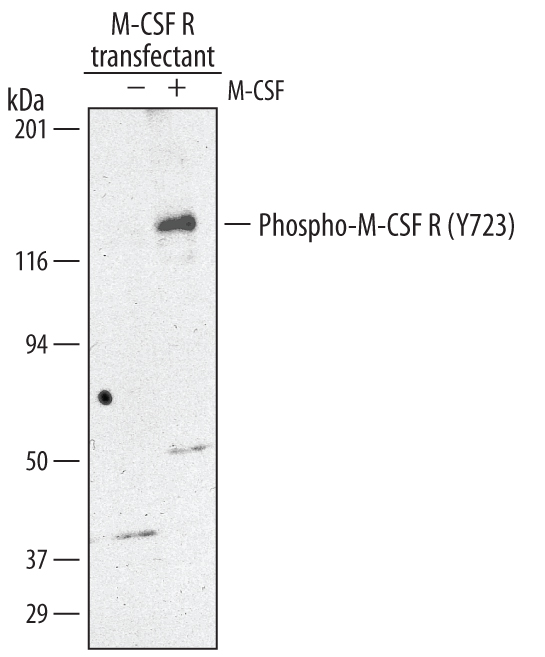Human Phospho-M-CSF R/CD115 (Y723) Antibody
R&D Systems, part of Bio-Techne | Catalog # AF3268

Key Product Details
Validated by
Species Reactivity
Applications
Label
Antibody Source
Product Specifications
Immunogen
Specificity
Clonality
Host
Isotype
Scientific Data Images for Human Phospho-M-CSF R/CD115 (Y723) Antibody
Detection of Human Phospho-M-CSF R/CD115 (Y723) by Western Blot.
Western blot shows lysates of M-CSF R/CD115-transfected NS0 mouse myeloma cell line untreated (-) or treated (+) with 100 ng/mL Recombinant Human M-CSF/CD115 (Catalog # 216-MC) for 10 minutes. PVDF membrane was probed with 0.5 µg/mL of Rabbit Anti-Human Phospho-M-CSF R/CD115 (Y723) Antigen Affinity-purified Polyclonal Antibody (Catalog # AF3268), followed by HRP-conjugated Anti-Rabbit IgG Secondary Antibody (Catalog # HAF008). A specific band was detected for Phospho-M-CSF R/CD115 (Y723) at approximately 175 kDa (as indicated). This experiment was conducted under reducing conditions and using Immunoblot Buffer Group 1.M-CSF R/CD115 in Human PBMCs.
M-CSF R/CD115 phosphorylated at Y723 was detected in immersion fixed human peripheral blood mononuclear cells (PBMCs) using Rabbit Anti-Human Phospho-M-CSF R/CD115 (Y723) Antigen Affinity-purified Polyclonal Antibody (Catalog # AF3268) at 10 µg/mL for 3 hours at room temperature. Cells were stained using the NorthernLights™ 557-conjugated Anti-Rabbit IgG Secondary Antibody (red; Catalog # NL004) and counterstained with DAPI (blue). View our protocol for Fluorescent ICC Staining of Non-adherent Cells.Applications for Human Phospho-M-CSF R/CD115 (Y723) Antibody
Immunocytochemistry
Sample: Immersion fixed human peripheral blood mononuclear cells
Western Blot
Sample: M‑CSF R‑transfected NS0 mouse myeloma cell line treated with Recombinant Human M‑CSF/CD115 (Catalog # 216-MC)
Formulation, Preparation, and Storage
Purification
Reconstitution
Formulation
Shipping
Stability & Storage
- 12 months from date of receipt, -20 to -70 °C as supplied.
- 1 month, 2 to 8 °C under sterile conditions after reconstitution.
- 6 months, -20 to -70 °C under sterile conditions after reconstitution.
Background: M-CSF R/CD115
M-CSF R, the product of the c-fms proto-oncogene, is a member of the type III subfamily of receptor tyrosine kinases that also includes receptors for SCF and PDGF. These receptors each contain five immunoglobulin-like domains in their extracellular domain (ECD) and a split kinase domain in their intracellular region (1‑4). M-CSF R is expressed primarily on cells of the monocyte/macrophage lineage, dendritic cells, stem cells and in the developing placenta (1). Human M-CSF R cDNA encodes a 972 amino acid (aa) type I membrane protein with a 19 aa signal peptide, a 493 aa extracellular region containing the ligand-binding domain, a 25 aa transmembrane domain and a 435 aa cytoplasmic domain. The human M-CSF R ECD shares 60%, 64%, 72%, 75%, 75% and 76% aa identity with mouse, rat, bovine, canine, feline and equine M-CSF R, respectively. Activators of protein kinase C induce TACE/ADAM17 cleavage of the M-CSF R, releasing the functional
ligand-binding extracellular domain (5). M-CSF binding induces receptor homodimerization, resulting in transphosphorylation of specific cytoplasmic tyrosine residues and signal transduction (6). The intracellular domain of activated M-CSF R binds more than 150 proteins that affect cell proliferation, survival, differentiation and cytoskeletal reorganization. Among these, PI3Kinase, P42/44 ERK and c-Cbl are key transducers of M-CSF R signals (3, 4). M-CSF R engagement is continuously required for macrophage survival and regulates lineage decisions and maturation of monocytes, macrophages, osteoclasts and DC (3, 4). M-CSF R and integrin alphav beta3 share signaling pathways during osteoclastogenesis and deletion of either causes osteopetrosis (7, 8). In the brain, microglia expressing increased M-CSF R are concentrated with Alzheimers a beta peptide, but their role in pathogenesis is unclear (9, 10).
References
- deParseval, N. et al. (1993) Nucleic Acids Res. 21:750.
- Rothwell, V.M. and L.R. Rohrschneider (1987) Oncogene Res. 1:311.
- Chitu, V. and E.R. Stanley (2006) Curr. Opin. Immunol. 18:39.
- Ross, F.P. and S.L. Teitelbaum (2005) Immunol. Rev. 208:88.
- Rovida, E. et al. (2001) J. Immunol. 166:1583.
- Yeung, Y. et al. (1998) J. Biol. Chem. 273:17128.
- Dai, X. et al. (2002) Blood 99:111.
- Faccio, R. et al. (2003) J. Clin. Invest. 111:749.
- Li, M. et al. (2004) J. Neurochem. 91:623.
- Mitrasinovic, O.M. et al. (2005) J. Neurosci. 25:4442.
Long Name
Alternate Names
Gene Symbol
Additional M-CSF R/CD115 Products
Product Documents for Human Phospho-M-CSF R/CD115 (Y723) Antibody
Product Specific Notices for Human Phospho-M-CSF R/CD115 (Y723) Antibody
For research use only

